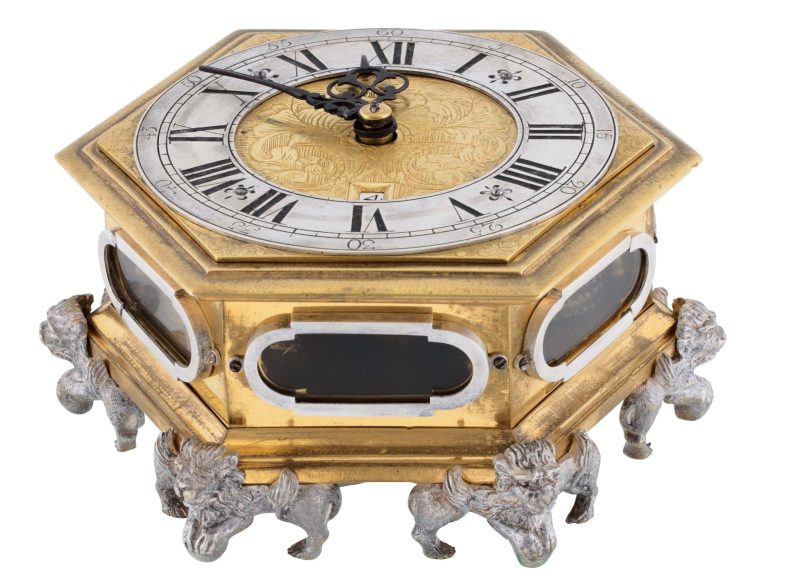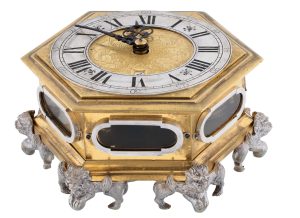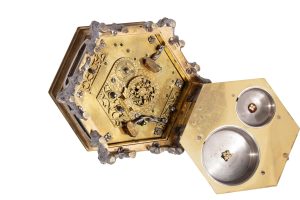masterpiece from Gdansk/Poland, second half of the 17th century
- Case
- engraved bronze, traces of original gilding, six silver-plated winged lion feet, six glazed windows
- Dial
- engraved ormolu dial, silver-plated dial ring, aperture for the indication of date
- Movement
- verge escapement with fusee, engraved spring barrels, quarter strike on bells with automatic release, repeater, plate with open work scrolling foliage, two engraved hammers, fine adjustment
- Measurements
- 6×6 ¾ in
The type of horizontal table clock originated in the Renaissance and is characterized by a horizontal arrangement of the gear train and a dial located on the top. This was made possible by the invention of the spring drive, which allowed the mechanism to be tilted and additionally making the clocks portable. It is another peculiarity that the bells for the striking mechanism are attached to the underside of the case. Consequently, no sound apertures are needed, but this positioning requires small feet. Glazed viewing windows, which allow exciting insights into the movement, are also typical. Therefore, visible parts of the clockwork are often decorated with floral and ornamental engravings.
The territory of today‘s Poland was a stronghold of the table clock tradition and was known for the excellent quality of those timepieces. The present hexagonal table clock with date display was probably also made by a great Gdansk master in the second half of the 17th century. The exceptionally large bronze case (6 x 6 ¾ in.) is engraved with floral scrolling foliage on the top. Inside the silver-plated chapter ring is a square opening with Arabic numerals – this is a date display, an extremely rare indication for table clocks. Six viewing windows with silver plated frames offer insights into the clockwork mechanism. One spring barrel is equipped with fusée-andchain transmission and operates the movement. The other two are engraved with tendril work and serve the quarter-hour striking mechanism with self-release – another rarity among the table clocks of that time, which were usually equipped only with an hour striking mechanism. Due to the quarter-hour striking mechanism, there are also two bells on the bottom of the case. The silverplated figural feet in the form of divided lions are a particularly elaborate variant, which is found primarily (but not exclusively) on clocks from Gdansk or Toruń. The plate is artfully designed with openwork fittings. In addition to vegetal engravings such as tendril work and laurel wreaths, there is also a mascaron. The heads of the two hammers for the quarter-hour striking mechanism are also imaginatively engraved.
This excellent hexagonal table clock with rare quarter-hour striking mechanism and date display is a showpiece of the baroque clockmaking art of Poland.


